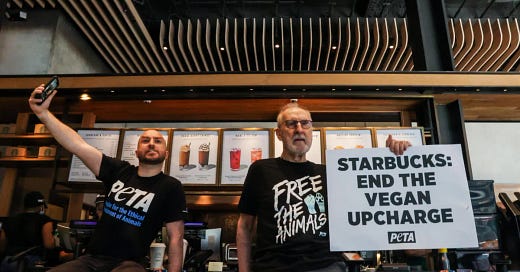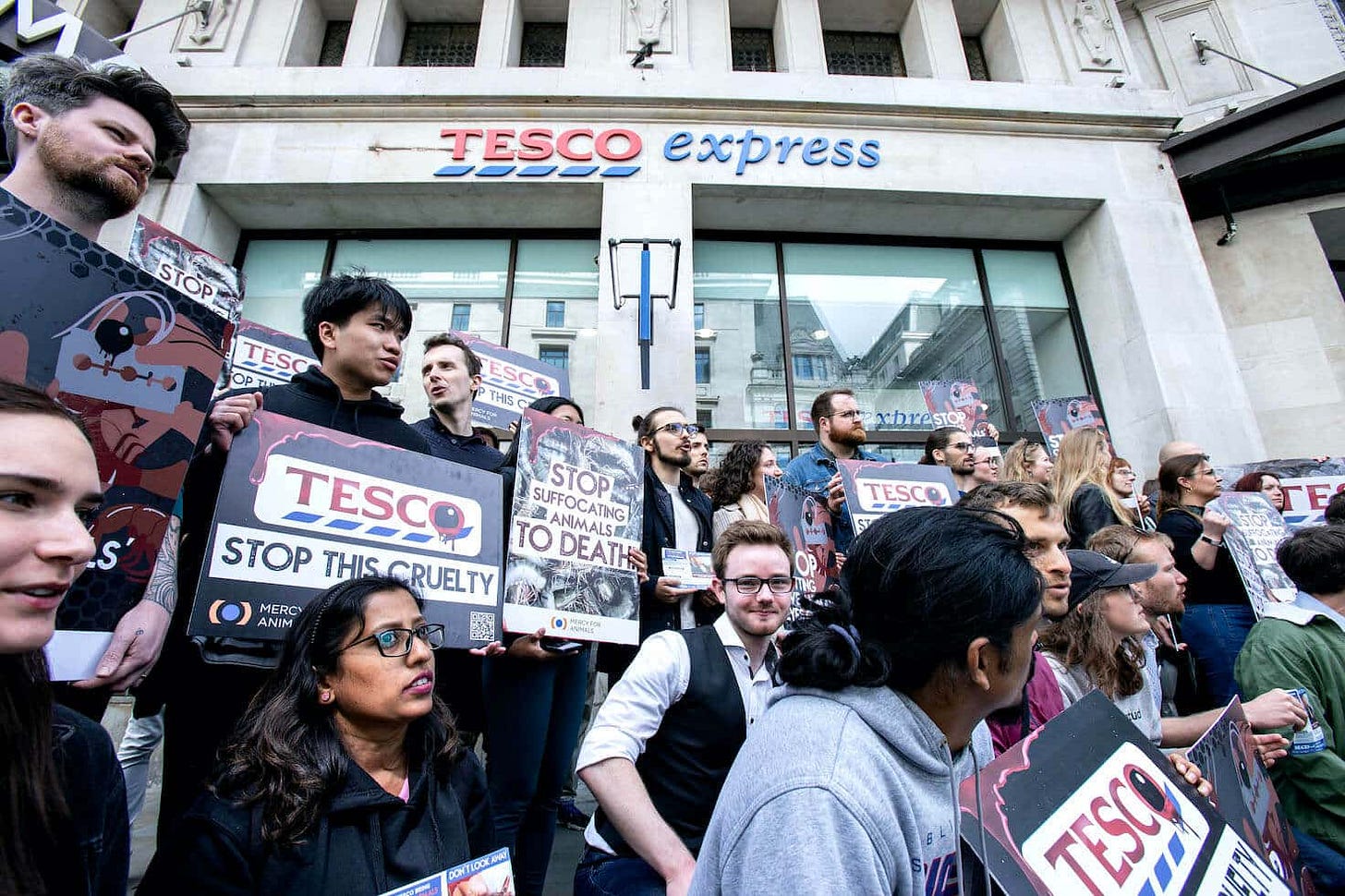I recently turned on paid subscriptions for the newsletter. If you like this article, please consider becoming a paid subscriber. In addition to all paywalled content, you’ll gain access to the subscriber chat on the Substack app, where you can request articles and podcast episodes about topics of your choice, and I’ll link to occasional article drafts and monthly paid-subscriber-only video calls. It’s just $5 per month (for now) so sign up today!
One of the lowkey victories of the animal protection movement in 2024 was getting Starbucks to drop the surcharge on plant-based milk. Starbucks uses over 540,000 gallons of dairy milk per day, or nearly 200 million gallons per year. If dropping the surcharge results in just 3% of dairy milk being replaced with plant-based alternatives, it may reduce the number of cows who are forcibly impregnated by the industry, separated from their calves, and injured and mutilated by as many as 3,000 per year, or the equivalent of shutting down four large factory farms.1
That’s an astonishing amount of good. But to a discerning movement, the proper evaluative question is not: “How much good?” But rather: “How much good was achieved compared to what could have been if the same resources had been applied elsewhere?” The Starbucks campaign run by PETA lasted for nearly five years and saved 3,000 cows. Let’s say conservatively that it expended some $500,000 in staff time and publicity. For the same amount of money:
The Humane League could have spared as many as millions of chickens from life in horrific battery cages.
Activists in Latin America and the Asia-Pacific could have gotten hundreds of people to embrace meatless diets.
The Shrimp Welfare Project could have prevented hundreds of millions of shrimp from being slaughtered in excruciating ice slurry.
It certainly seems like there are plenty of more deserving causes that PETA could have spent its resources on. Nevertheless, I want to defend the position that the Starbucks campaign was worth it even if you consider opportunity costs, because organizations often face different tradeoffs than funders. (To be clear, I’m not saying that funders should support more PETA-style campaigns, but that it’s sometimes worthwhile for organizations to prioritize efforts that might otherwise be considered sub-optimal.)
Consider first what it must be like to be a funder. You can spend money virtually anywhere, so there is a clear tradeoff between supporting more and less effective forms of animal advocacy. If your resources are scarce and rivalrous — you don’t have unlimited money — any dollar that’s given to cause X is a dollar that can’t be given to cause Y. If you’re interested in doing the greatest amount of good you can, you should choose to support whatever cause accomplishes the most good per dollar on the margin: that is, something like shrimp welfare and not Starbucks protests.
Contrast this with what it is like to be a volunteer or an organizer. Time and talent aren’t fungible like money, so it’s not always clear that you could be supporting something more effective than one of the less effective causes like protests and vegan outreach. Many of the most impactful animal charities are only in demand for volunteers with a very specific skill set that most people don’t have, like data analysis or legal research, or they operate primarily in the Global South and don’t have opportunities for people who live in the largest donor countries and don’t speak specific languages. Much of the time, “more effective” isn’t an option, which means the tradeoff is really between “less effective” and “nothing.”
Similarly if you’re an organization, you have to consider what motivates your potential volunteers and funders, which means you often face a tradeoff between selecting a campaign that’s highly impactful and selecting one that generates an optimal level of enthusiasm. Most people aren’t effective altruists, and many people who could be convinced to turn out for a protest against Starbucks might bristle at a more marginal cause like shrimp welfare or wild animal suffering. This is hopefully changing — see below2 — but until the day when effective altruism is vindicated as the end point of mankind’s ideological evolution and universalized as the final form of human rationality, it will still sometimes be worth it for organizations to launch otherwise sub-optimal campaigns that raise more money from people who wouldn’t otherwise donate and get more people involved in the movement who wouldn’t otherwise get involved.
When you look at PETA this way, a lot of their decisions start to make more sense. It’s unlikely that by running campaigns against less widespread and egregious forms of animal exploitation like circuses and rodeos that they’re drawing resources away from organizations focused on factory farming. To the contrary, most PETA funding comes from small-dollar donors who probably wouldn’t otherwise give to effective altruist causes, while PETA-style activism is often a gateway into more effective forms of animal advocacy. Bruce Friedrich, founder of the highly effective Good Food Institute, got his start at PETA as the architect of flashy public campaigns aimed at awareness-raising. Alene Anello, founder of Legal Impact for Chickens, also began as a PETA staffer.
One highlight of the Starbucks campaign in 2022 was when PETA recruited actor James Cromwell to glue his hand to the counter of a Starbucks location in Manhattan to raise awareness and get earned media attention. I doubt that Cromwell would have gotten as much attention if he had glued his hand to a shrimp trawler. But I bet that some of the people who took notice or joined the protests against Starbucks have since stopped eating shrimp or begun to advocate for aquatic animals. The Animal Rights Initiative — PETA’s main local partner in the Starbucks campaign — has gone on to score impressive legislative victories in California and Washington to ban octopus farming.
To come back full circle, this doesn’t mean that people who donate to highly effective charities should start diverting their giving to less effective ones, or that more organizations should deliberately choose to run more sub-optimal campaigns. But it also doesn’t mean that activists who pride themselves on being effective should ignore, disparage, or look down upon the members of their coalition who apparently fail to optimize at every turn. In fact, it might be worthwhile to start raising the profile of more small victories like the one against Starbucks and to encourage more people who are interested in doing good things to get their foot in the door with lower-impact activism instead of jumping head-first into cause areas like shrimp welfare, which are off-putting to most people. When the opportunity costs are close to zero or negative, even the “less effective” causes can be a form of effective altruism.
It might also reduce greenhouse gas emissions by up to 60,000 tons per year, which would avoid a marginal increase in global temperatures and thereby prevent a likely increase in r-selection among species affected by climate change, which is the predominant source of suffering among animals in the wild.
Earlier this year, Mercy for Animals held the world’s first ever shrimp welfare protest and turned out a whopping 70 participants. They also collected over 7,000 signatures on a successful petition to Tesco to adopt a crustacean welfare policy affecting more than 5 billion shrimp per year. One observer recently noted: “If we assume the petition was responsible for 20% of the success, that’s 142,857 shrimps helped per petition signer!”






I don’t think PETA is a great example given that there is a good chance that they are a net negative for the movement.
Interesting in theory. The specifics of PETA or any other case will depend on the numbers (they’re probably incurring _some_ opportunity costs), and that sort of thing can’t be determined from the armchair.